Millennials prefer pets to children (Survey)
… And they love their animals more than their siblings

You probably feel it: Pet love is at an all-time high. Animal shelters have been emptied in recent years, the pet industry continues to grow by the billions annually, and viral pet videos are getting more and more views.
But one generation seems to have truly bonded with their pets more than the rest. According to the American Pet Products Association’s (APPA) National Pet Owners Survey, millennials make up the biggest share of pet owners in the U.S. and spend more money on their animals than any other age group.
To map out pet ownership in the U.S., we spoke to 1,000 pet owners, nearly half of which were millennials between 27 and 42 years old. They answered some surprisingly not-so-difficult questions about how their pets ranked against family members for their affection and the lengths they were willing to go to meet pet-related costs. If you’re curious to see how the love you have for your own pet stacks up against that of the average millennial, keep reading.
Key findings
- Fifty-seven percent of millennials said they love their pet more than their sibling — 50% said the same about their mother, and 30% said the same of their partner.
- One in 4 millennials said they would be willing to sell their car to afford a life-saving procedure for their pet.
- Maine was found to be the most pet-friendly state; New York was the least.
Millennials’ must-have family members
The study began with a heavy hitter: Which family members do you love less than your pet? To get a sense of how things may look in the future, we also asked respondents whether they’d rather have fur babies than (human) children of their own.
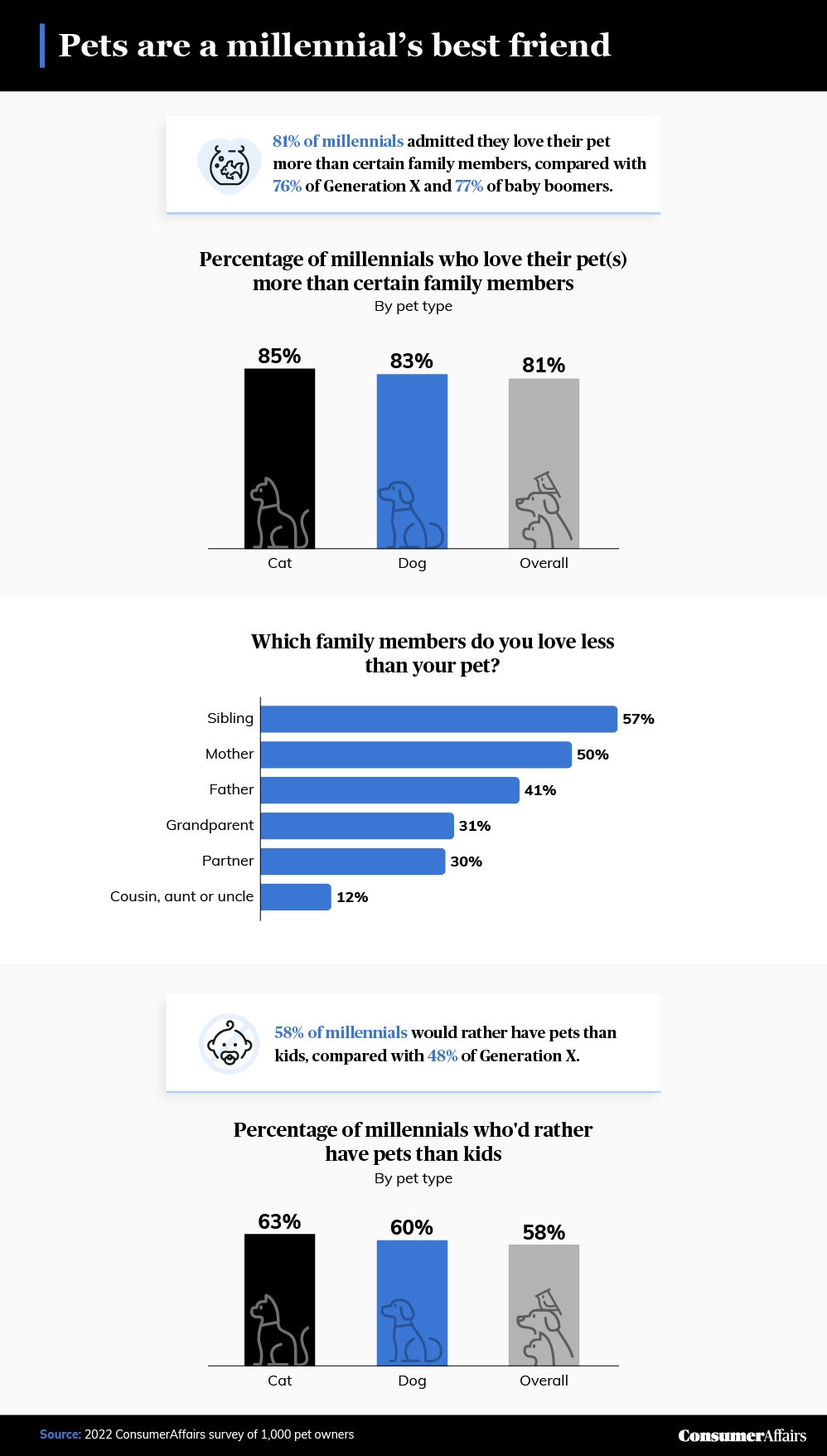
The vast majority (81%) of millennials admitted to loving their pets more than at least one family member — and this doesn’t mean a weird uncle or an estranged cousin. Our survey showed it was actually most often their own siblings: 57% loved their pets more than their brother or sister, and exactly half claimed to love their pets more than their own mother. Even romantic partners still came second to a pet for 30% of respondents.
Previous studies have shown that millennials are less likely to own homes and have children than the generations before them. Evidently, pets may have a lot to do with this. Fifty-eight percent of millennials said they’d prefer to have pets over human children. This was especially true for cat owners, among whom the percentage jumped to 63%.
Cost of loving your pets
We may give our love freely to our animals, but that doesn’t mean there isn’t a very real price to keeping them around. Here we looked at how much pet owners were willing to spend on the health of their pets, how confident they were that they could afford an emergency treatment and the lengths they’d go to if unable to afford vital pet care.
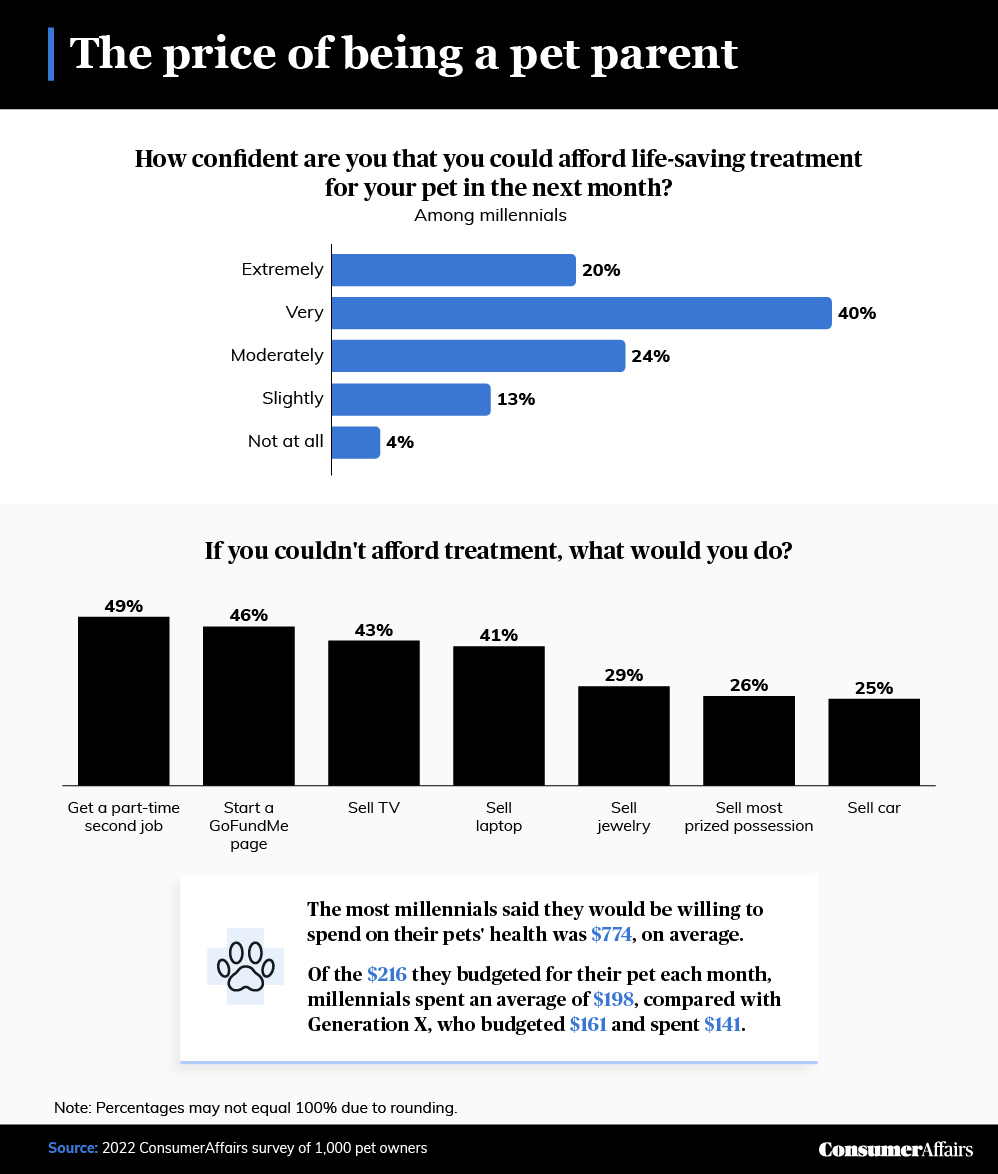
Overall, millennials were pretty confident they could afford a life-saving treatment for their pets within the next month. 60% were very or extremely confident, and 84% were at least moderately confident. Only 17% had a slight amount of confidence or less. This confidence could be naive, though — millennials have been proven to be financially worse off than other generations, even without the cost of children and mortgage payments. Hypothetical life-saving treatments aside, millennials reported spending an average of $198 on their pet every single month, or $2,376 annually — 60.4% more than the average American dog owner.
If push came to shove and millennials truly couldn’t afford a life-saving treatment for their animal, they reported a willingness to take on a part-time second job (49%) or sell possessions such as TVs (43%), laptops (41%) or jewelry (29%).
One of the most popular choices, however, was to start a GoFundMe page (46%). This is a tried-and-tested tactic; many Americans have already turned to the crowdfunding site to raise money for pet surgeries — so much so that GoFundMe has an entire article walking its users through this exact process.
Real-life doghouses
Remember doghouses? A doghouse these days might not be something you buy for your pet to live in, but something you buy for you and your pet to live in. The next piece of the study asked pet owners how heavily their pets influenced where they decided to live.
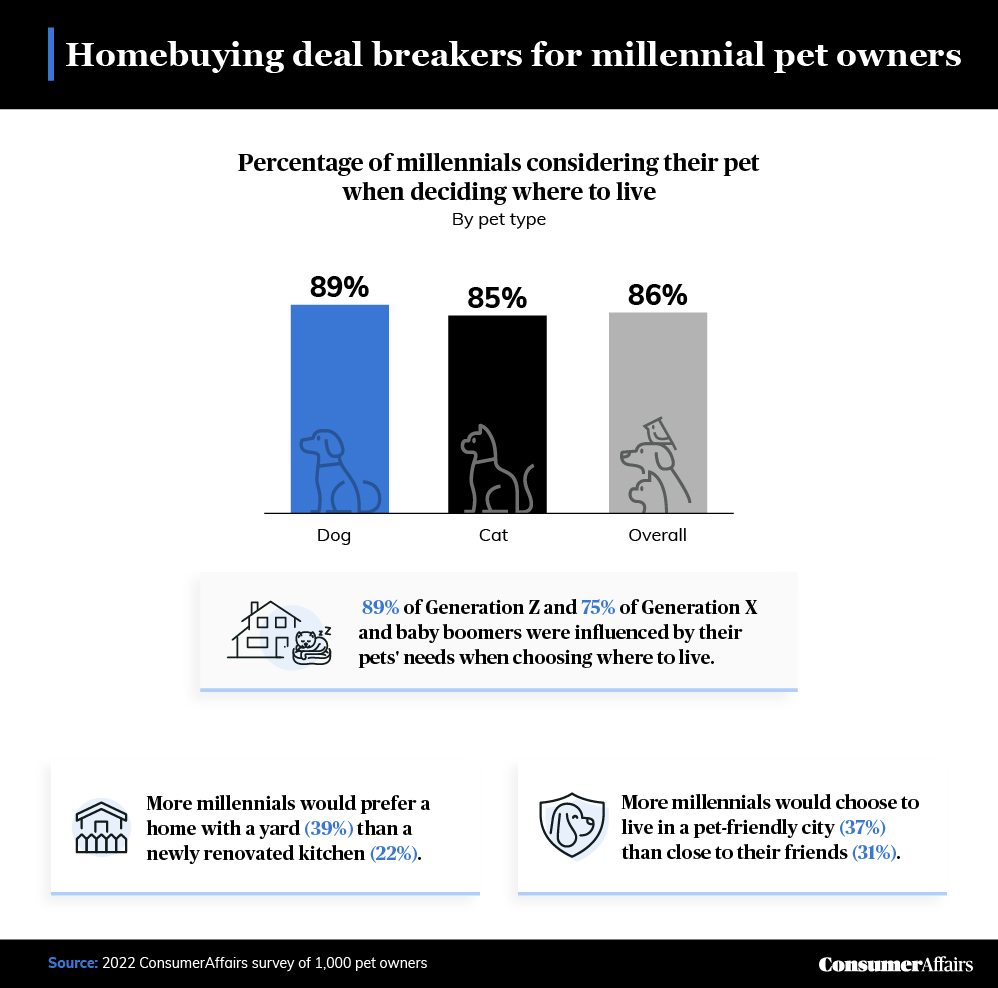
Both dogs and cats greatly influenced their owners’ living situation. Eighty-nine percent of dog owners and 85% of cat owners agreed that they kept their pets in mind when choosing where to live. Millennials also prioritized living in a pet-friendly city over living near their friends and having a yard for their pets over a home with a newly renovated kitchen.
In addition to these hypothetical social and lifestyle costs, there’s also a very real financial cost associated with bringing a pet into an apartment. Landlords may charge $25 to $100 each month in addition to a hefty deposit for the privilege of living with your four-legged friend — and that’s if the building allows pets in the first place. According to the Humane Society, rental properties denying applicants with pets is a leading cause of animals being left at shelters.
Ideal locations for your pet’s best life
One key hallmark of a pet-friendly area is a dog park. According to the National Recreation and Park Association, dog parks not only enable pets to exercise and socialize, but they provide those very same benefits for their owners. Our final piece of research ranked the top U.S. cities by their number of dog parks per 100,000 residents.
We also ranked states for pet friendliness by comparing the number of pet owners with the number of veterinarians. After all, the availability of good health care is another important aspect for pet owners to consider when deciding where to live.
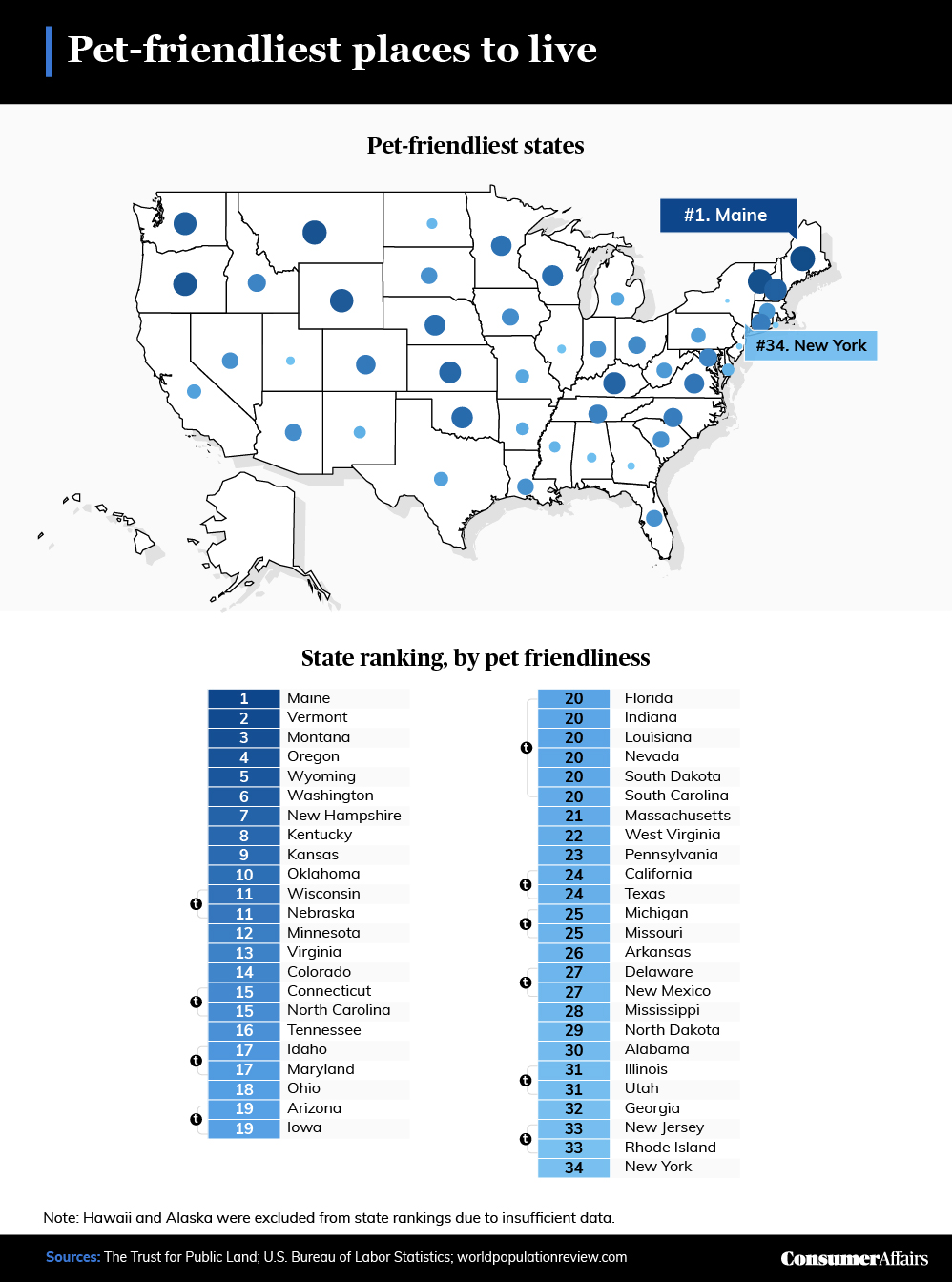
The top pet-friendly states, based on the number of pet owners and veterinarians, were also those with plenty of pristine outdoor space, with Maine ranking first, Vermont ranking second, Montana in third and Oregon in fourth (that said, there is a hot debate among veterinarians regarding whether city or country dogs are healthier).
Though country dogs may benefit from more backyard space, they have to deal with more tick, flea and heartworm issues than those in cities.
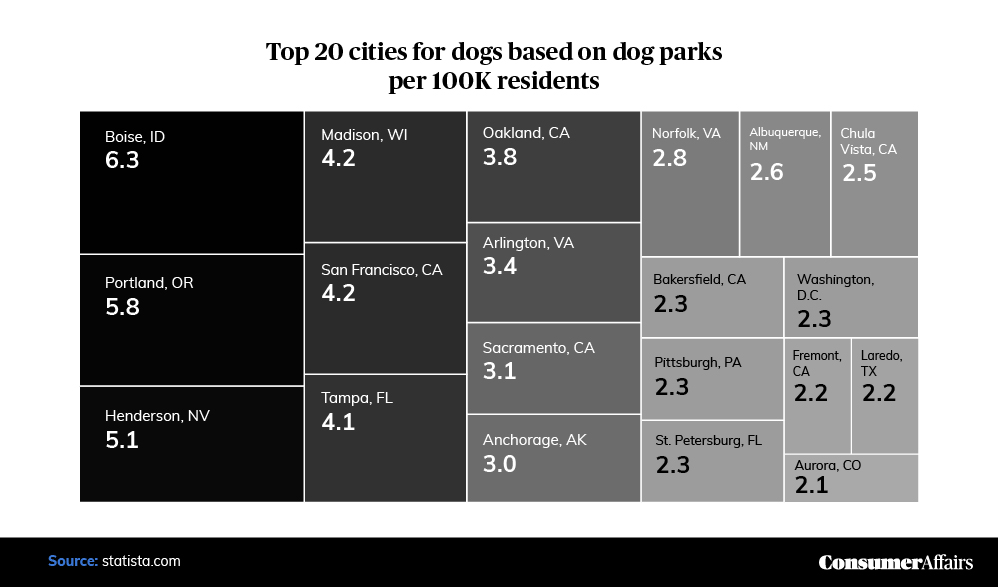
Of course, there are plenty of happy city dogs, especially in Boise, Idaho, and Portland, Oregon, which ranked first and second as the dog-friendliest cities in America, respectively, with more dog parks per 100,000 residents than any others. Boise even has a well-organized website dedicated to helping owners navigate the many off-leash parks in the area, while Portland has a dog-specific hotline for owners to call and ask questions.
Fitting pets into your life and budget
Evidently, having pets is something most millennials want; respondents reported spending thousands of dollars per year and even considered additional jobs to meet their pets’ financial needs. They often admitted to loving their dogs and cats more than their own family members, and, in many cases, preferred them over having actual children.
That said, all this pet love comes at a cost. Most were already spending upward of $2,000 per year on their pets, which industry experts estimate will only continue to grow. While the costs of owning a pet are likely to change, one thing that will surely stay constant is how much millennials love their furry companions.
Methodology and limitations
We surveyed 1,000 pet owners ranging across all generations in order to explore the pull of pet ownership. Among respondents, 20% were Gen Zers, 44% were millennials, 20% were Gen Xers and 16% were baby boomers.
To help ensure accurate data, all respondents were required to identify and correctly answer a decoyed attention-check question. This data relies on self-reporting.
In order to create a unique ranking of the pet-friendliest states, we created a metascore system that considers two variables: pet ownership by state and number of veterinarians by state. We then calculated the number of veterinarians per pet owner by state. Separately, we explored the cities with the most off-leash dog parks per 100,000 residents.
Fair use statement
Pet ownership is clearly expensive and time-consuming — but full of love. If you know someone who would appreciate the findings of this pet owner study, you’re welcome to share it widely. Just be sure your purposes are noncommercial and that you link back to this page.
You’re signed up
We’ll start sending you the news you need delivered straight to you. We value your privacy. Unsubscribe easily.